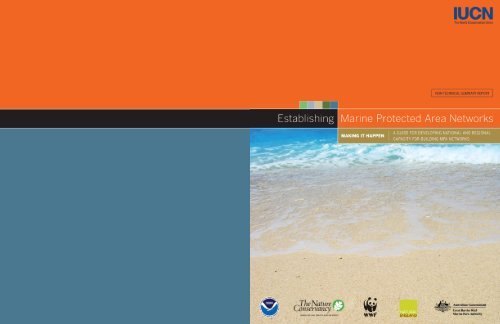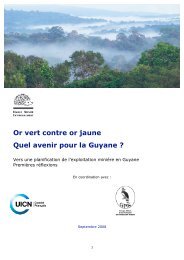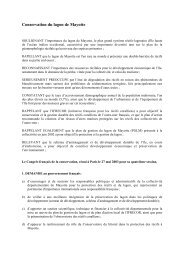Establishing Marine Protected Area Networks - Georgia Strait Alliance
Establishing Marine Protected Area Networks - Georgia Strait Alliance
Establishing Marine Protected Area Networks - Georgia Strait Alliance
Create successful ePaper yourself
Turn your PDF publications into a flip-book with our unique Google optimized e-Paper software.
CONTENTS<br />
INTRODUCTION & BACKGROUND<br />
introduction and background to this report 1<br />
❏ why do we need marine protected area (mpa) networks? 2<br />
What is an MPA network?<br />
Why are MPA networks important for sustainable development?<br />
❏ what are the ecological design criteria for mpa networks? 4<br />
Representativeness<br />
Replication<br />
Viability<br />
Precautionary design<br />
Permanence<br />
Maximum connectivity<br />
Resilience<br />
Size and shape<br />
❏<br />
❏<br />
❏<br />
what are the best practices for planning and implementing<br />
mpa networks? 6<br />
Clearly define objectives<br />
Establish long-term political commitment and will<br />
Encourage stakeholder participation<br />
Make best use of available information<br />
Develop integrated management frameworks<br />
Employ adaptive management techniques<br />
what are the broader considerations needed to ensure that<br />
mpa networks are set in context? 8<br />
Economic and social considerations<br />
Spatial and temporal considerations<br />
Scientific and information management considerations<br />
Institutional and governance considerations<br />
what are the key elements needed to make mpa networks<br />
happen and achieve their goals? 12<br />
Political will and leadership<br />
Public education, communication and awareness<br />
Monitoring and assessment<br />
Sustainable financing<br />
Compliance and enforcement<br />
the next steps 16<br />
acknowledgements 16<br />
Regardless of where we live, all people depend upon healthy<br />
ocean ecosystems.The role that marine protected areas<br />
(MPAs) can play in promoting the health of our oceans and<br />
seas has been recognized at the highest levels.The World<br />
Summit on Sustainable Development, the IUCN’s World<br />
Commission on <strong>Protected</strong> <strong>Area</strong>s, the Convention on<br />
Biological Diversity, and the G8 group of Nations have all<br />
called for establishing a global system of MPA networks by<br />
the year 2012. Our challenge is to transform these commitments<br />
into meaningful action.<br />
Yet global progress on building marine protected area (MPA)<br />
networks has been slow, in part because they embrace a range<br />
of issues greater than conservation alone. For conservationists<br />
and natural resource managers, identifying the conservation<br />
actions needed to establish MPA networks can be a difficult<br />
process, but including concerns outside their immediate sphere<br />
of experience can be even more challenging and complex.This<br />
is where this report comes in. It seeks to capture emerging<br />
international best practice on the full range of considerations<br />
needed to build such networks.<br />
The following considerations are essential to developing<br />
successful MPA networks:<br />
❏ eight ecological criteria of network design;<br />
❏ six areas of best practices for establishing networks;<br />
❏ four broader considerations to help successfully embed<br />
MPA networks within a wider social context; and<br />
❏ five key elements to make MPA networks happen and<br />
achieve their goals.<br />
Key aspects of building MPA networks<br />
public education,<br />
communication<br />
& awareness<br />
monitoring<br />
& assessment<br />
Making It Happen<br />
ecological design criteria<br />
best practices for planning &<br />
implementation<br />
selling MPA networks in a broader context<br />
economic & social considerations<br />
spacial & temporal considerations<br />
scientific & information management considerations<br />
institutional & governance considerations<br />
sustainable financing<br />
political will<br />
& leadership<br />
compliance &<br />
enforcement<br />
Many of these issues are highly inter-related, but have been<br />
separated out in this report for ease of description and<br />
communication. Issues such as the need for public education<br />
and political will are pertinent throughout the process of<br />
establishing MPA networks. No sequence or hierarchy is<br />
implied; in fact, all elements included in this report are<br />
seen as fundamental to implementing MPA networks.The<br />
emphasis on particular issues will change, depending on<br />
the individual circumstances of each region or country.<br />
This summary is intended to help:<br />
❏ politicians, policy advisors and decisions makers who have<br />
a role in ensuring that policy commitments to establish MPA<br />
networks become a reality;<br />
❏ the donor community supporting work on MPA networks<br />
in assessing the importance of proposals;<br />
❏ planners, managers and other practitioners at regional,<br />
national and local levels who implement MPA networks to<br />
set their actions within a broader comprehensive setting; and<br />
❏ international organizations, especially regional seas conventions,<br />
who act as enabling bodies for implementing agreed<br />
commitments to deliver MPA networks.<br />
From this work, three things are clear:<br />
❏ no single strategy can succeed in all circumstances; rather,<br />
network designers must consider and draw from a broad<br />
matrix of inter-related elements;<br />
❏ MPA networks need to be more than just lines on maps;<br />
managers need to make a real difference by sustaining or<br />
recovering wildlife and ecosystem processes; and<br />
❏ work on building networks should start now if we are<br />
to accomplish the 2012 goal and achieve meaningful conservation<br />
benefits worldwide.<br />
This summary and the full technical report are intended to<br />
provide designers and managers with a solid framework for<br />
beginning the process. But strategies for individual networks<br />
will need to evolve over time.<br />
We hope that this document will improve people’s understanding<br />
of what it takes to build successful MPA networks.<br />
We also hope that it will guide the entities involved in building<br />
the capacity they needed to deliver such networks.Without<br />
question, MPA networks can provide enormous benefits to<br />
the ocean environment, to communities and to nations. But<br />
none of this will happen unless people commit the practical<br />
and political resources to start now.<br />
Introduction & Background | 1
WHY DO WE NEED MPA NETWORKS?<br />
The best available scientific information tells us that, to protect<br />
biodiversity and manage resources, we must establish representative<br />
MPA networks across 20 to 30 percent of our seas and oceans.These networks<br />
may have different uses and levels of protection within them, but all should include<br />
reserves or no-take areas and should include representative examples of the<br />
different ecosystems, habitats and communities in our seas and oceans.<br />
Yet most countries and regions have only just started to develop small MPAs,<br />
and many have only one or a few MPAs. It is unrealistic to expect that building<br />
MPA networks can be achieved in a single step. Instead, planners should expect<br />
to develop a gradual strategy for implementing a full network.<br />
In the beginning, countries and regions may want to focus on developing a few<br />
well-managed MPAs that benefit local communities.These areas can be used to<br />
model the benefits of the larger network for decision makers and the public at<br />
large.At all times, however, MPA networks must be viewed realistically and in<br />
context; they cannot solve broader deficiencies in ocean governance or management.<br />
What is an mpa ‘network’?<br />
An MPA network is an organized collection of individual<br />
sites, designed to link individual areas and to<br />
comprehensively represent the region’s spectrum<br />
of marine life characteristics. International commitments<br />
to MPA networks recognize that they fulfill<br />
ecological and social aims that a single MPA alone<br />
cannot. Given the difficulty of coordinating actions<br />
among many countries at once, a global system<br />
of MPAs will most likely consist of national and<br />
regional networks distributed across the globe.<br />
An MPA network can therefore be defined as:<br />
A collection of individual marine protected<br />
areas operating cooperatively and synergistically,<br />
at various spatial scales, and with a range of<br />
protection levels, in order to fulfil ecological<br />
aims more effectively and comprehensively than<br />
individual sites could alone. The network will<br />
also display social and economic benefits, though<br />
the latter may only become fully developed over<br />
long time frames as ecosystems recover.<br />
<strong>Area</strong>s with full protection – that is, areas where no<br />
extractive activities such as fishing or the removal<br />
of resources are permitted – should be part of<br />
every network.These areas act as benchmarks for<br />
assessing the state of the environment and the<br />
success of management regimes; they also contribute<br />
significantly to the recovery and protection of marine<br />
ecosystems.The proportion of fully protected areas<br />
versus less strictly protected areas within a network<br />
will depend on the degree of protection and recovery<br />
being sought and the level of decline in an area’s<br />
marine resources.<br />
Why are mpa networks important for<br />
sustainable development?<br />
MPA networks contribute to sustainable development<br />
goals by fostering integrated ocean and<br />
coastal management.<br />
❏ Ecologically. A network can help to ensure<br />
marine ecosystem function by encompassing the<br />
temporal and spatial scales at which ecological<br />
systems operate.<br />
❏ Socially. A network can help resolve and<br />
manage conflicts in the use of natural resources<br />
and ensure that reasonable uses can occur with<br />
minimal conflict.<br />
❏ Economically. A network facilitates the efficient<br />
use of resources by preventing duplication of effort,<br />
such as when small, individual areas attempt to<br />
maintain their own management resources.<br />
Representative networks of MPAs – those that<br />
contain examples of all habitats and ecological<br />
communities of a given area – also provide a costeffective<br />
means of safeguarding large-scale processes<br />
while delivering local benefits. <strong>Networks</strong> can also<br />
help reduce the degradation of coastal and marine<br />
habitats, slow the loss of endangered marine<br />
species, and restore depleted fisheries.<br />
2 | <strong>Establishing</strong> <strong>Marine</strong> <strong>Protected</strong> <strong>Area</strong> <strong>Networks</strong><br />
<strong>Establishing</strong> <strong>Marine</strong> <strong>Protected</strong> <strong>Area</strong> <strong>Networks</strong> | 3
W<br />
HAT<br />
ARE THE ECOLOGICAL<br />
DESIGN CRITERIA FOR MPA<br />
NETWORKS?<br />
These eight criteria can help identify the ecological considerations that lie at<br />
the heart of designing MPA networks:<br />
Representativeness. MPA networks should represent the range of marine and<br />
coastal biological diversity (from genes to ecosystems) and the associated<br />
physical environment within the given area.<br />
Replication. All habitats in each region should be replicated within the network<br />
and distributed spatially throughout the network.<br />
Viability. MPA networks should incorporate selfsustaining,<br />
geographically dispersed component sites<br />
of sufficient extent to ensure population persistence<br />
through natural cycles of variation.These sites should<br />
be independent (as far as possible) of activities in<br />
surrounding areas.<br />
Precautionary design. Network designers should<br />
base their decisions on the best information currently<br />
available, rather than delaying the process to await<br />
more and better information.Where information<br />
is limited, designers should adopt a precautionary<br />
approach.<br />
Permanence. Network design must provide longterm<br />
protection to effectively conserve diversity<br />
and replenish resources.<br />
Maximum connectivity. MPA network design should<br />
seek to maximize and enhance the linkages among<br />
individual MPAs, groups of MPAs within a given ecoregion,<br />
or networks in the same and/or different<br />
regions.<br />
Resilience. MPA networks must be designed to<br />
maintain ecosystems’ natural states and to absorb<br />
shocks, particularly in the face of large-scale and<br />
long-term changes (such as climate change).<br />
Size and shape. Individual MPA units within the<br />
network must be of sufficient size to minimize<br />
adverse impacts from activities outside the protected<br />
area (avoiding what is called the “edge effect”).<br />
The scale of benefits derived from individual MPAs<br />
will depend on their location, design, size, and<br />
relationship to other forms of management. MPA<br />
networks magnify the benefits of individual sites<br />
and protect the large-scale processes that maintain<br />
healthy populations, such as connectivity, gene flow<br />
and genetic variation.<br />
4 | <strong>Establishing</strong> <strong>Marine</strong> <strong>Protected</strong> <strong>Area</strong> <strong>Networks</strong> <strong>Establishing</strong> <strong>Marine</strong> <strong>Protected</strong> <strong>Area</strong> <strong>Networks</strong> | 5
WHAT ARE THE BEST PRACTICES FOR<br />
PLANNING AND IMPLEMENTING<br />
MPA NETWORKS?<br />
By following the key best practices below during network design and development,<br />
planners can create networks that achieve maximum environmental, economic,<br />
and social benefits.<br />
Clearly define network objectives.<br />
At the very outset, designers must clearly define objectives in three broad areas:<br />
❏ Ecological objectives seek to protect, manage and/or restore marine ecosystems<br />
and their components;<br />
❏ Economic objectives determine how the region will benefit from the network,<br />
and who may suffer negative economic impacts;<br />
❏ Socio-cultural objectives include the full range of benefits that biodiversity<br />
provides, especially those that directly affect human health and well-being.The<br />
lead organization should work to ensure that all MPA network objectives are<br />
determined through an open, transparent and balanced process involving users,<br />
industry, government representatives, and other groups with an interest in the<br />
area.Timetables for achieving targets and milestones should be appropriate,<br />
realistic and err on the side of caution.<br />
Establish long-term political commitment and will.<br />
Political commitment and will must be established early in the process and<br />
maintained throughout. In some regions, the political will and resources needed<br />
to implement all components of a network may already exist. But in most cases,<br />
implementing an MPA network will take time, as political will and commitment<br />
for the network and component sites build. The<br />
more aware elected officials are of the planning<br />
process and of community support, the more they<br />
will support the network during planning, implementation<br />
and beyond.<br />
In some parts of the world, legal frameworks are<br />
often the only way to ensure consistency or to avoid<br />
the concept of a “paper park”-that is, a park that<br />
has been announced or designated, but not truly<br />
implemented.Voluntary support can be susceptible<br />
to changes in political priorities; these changes can<br />
force governments to focus on short-term gains at<br />
the expense of longer-term and wider benefits for<br />
society as a whole.<br />
Encourage stakeholder participation.<br />
Developing effective MPA networks requires involving<br />
relevant stakeholders from the very beginning.<br />
Engaging stakeholders enhances information<br />
exchange, fosters the accountability of experts and<br />
authorities, reduces mistrust in the decision-making<br />
process, and enables stakeholder groups to collaborate<br />
and find mutually acceptable solutions.An<br />
open, participatory process also fosters a sense of<br />
ownership and accomplishment among the groups<br />
involved, thereby strengthening support and political<br />
will for the MPA network.Timely, planned consultation<br />
processes operating at meaningful spatial scales<br />
are critical to success.These include indigenous<br />
community meetings led by traditional leaders,<br />
government-sponsored opportunities for information<br />
sharing and comment, or inter-governmental planning<br />
meetings.<br />
Make best use of available information.<br />
Rather than waiting for perfect data, involved parties<br />
must use the best information available for gap<br />
analysis, planning and decision making.This information<br />
should not only consist of scientific and socioeconomic<br />
data, it should include traditional and<br />
local ecological knowledge-the knowledge that<br />
indigenous and local groups have gained about an<br />
area’s ecology, accumulated by experience and<br />
passed through generations. New data that emerges<br />
during or after the planning process can be applied<br />
through adaptive management. Delaying design and<br />
implementation rarely, if ever, benefits marine conservation.<br />
Develop integrated management frameworks.<br />
It is important to establish a hierarchy of planning<br />
and management scales, ranging from national planning<br />
frameworks to regional and local coordination,<br />
to local planning and site planning.A spatially based<br />
planning system will help coordinate and improve<br />
management; separate conflicting uses; and ensure<br />
appropriate spatial allowances for industry, wildlife<br />
and healthy ecosystems.When ecological boundaries<br />
are not consistent with jurisdictional or political<br />
boundaries, planners can help ensure consistency<br />
across jurisdictions by creating management strategies<br />
that mirror each other in most aspects, such as<br />
rules and regulations, but still retain unique jurisdictional<br />
aspects.<br />
Employ adaptive management techniques.<br />
“Adaptive management” means using the best<br />
available information to develop the MPA network<br />
and creating monitoring and evaluation systems<br />
to test the effectiveness of management methods<br />
and refine them over time.Adaptive management<br />
empowers managers to assess the success of their<br />
efforts and to adapt their methods as conditions<br />
and knowledge change.<br />
Adaptive management can be used to improve<br />
management capacity and effectiveness, particularly<br />
through professional development programs for<br />
network managers and staff. Capacity building also<br />
leverages opportunities to attract and provide<br />
additional expertise, resources and technology to<br />
the MPA.<br />
6 | <strong>Establishing</strong> <strong>Marine</strong> <strong>Protected</strong> <strong>Area</strong> <strong>Networks</strong> <strong>Establishing</strong> <strong>Marine</strong> <strong>Protected</strong> <strong>Area</strong> <strong>Networks</strong> | 7
W<br />
HAT<br />
ARE THE BROADER<br />
CONSIDERATIONS NEEDED TO<br />
ENSURE THAT MPA NETWORKS<br />
ARE SET IN CONTEXT?<br />
To help ensure the success of MPA networks, designers must also reflect on:<br />
Economic and social considerations:<br />
❏ Integrate the network into the economic and socio-cultural setting and<br />
promote activities that maximize positive benefits.Planners need to identify<br />
the broad costs and benefits provided by effectively managed MPA networks, as<br />
well as the indirect and opportunity costs incurred by people living in and around<br />
protected areas. One tool for making these calculations is economic valuation<br />
of consumptive and non-consumptive activities and non-use values, such as those<br />
provided by ecosystem services. Current social relationships and aspirations,<br />
cultural traditions and values, and political processes that influence attitudes and<br />
decisions about coastal and marine resource use and protection are also important<br />
considerations.<br />
❏ Evaluate the economies of scale provided by networks, as well as the<br />
costs of inaction. Network planners should consider the increased benefits and<br />
economies of scale when moving from an individual MPA to a network of MPAs,<br />
as well as the costs of inaction – that is, of not creating a network. For example,<br />
MPA networks may provide value-added benefits over individual MPAs, such as<br />
increased ecosystem services and reduced management costs per unit area.<br />
Spatial and temporal considerations reflect the<br />
fact that ecosystems function at different scales and<br />
change over time due to factors such as human<br />
activities or climate change. Planners should:<br />
❏ Take actions to address ecological processes,<br />
resources and impacts that extend beyond network<br />
boundaries or influence MPA networks.<br />
Network design must account for connectivity<br />
within and between networks, as well as the<br />
impacts of activities outside network boundaries,<br />
including upstream areas such as catchments. Given<br />
the fluid nature of the ocean environment, network<br />
planners must apply all available information on<br />
biological, chemical, and physical linkages–within<br />
the network and beyond.<br />
❏ Address the concept of “shifting baselines”<br />
in network design. The “shifting baseline syndrome”<br />
is the failure of managers and decision makers<br />
to fully grasp the enormous changes that have<br />
occurred in ocean ecosystems because they have<br />
occurred gradually over many years. Managers<br />
often fail to see that their baseline already represents<br />
a disturbed state.Therefore, it is especially<br />
important that planners set historically appropriate<br />
objectives for the MPA network.<br />
Scientific and information management<br />
considerations. Science and information play<br />
fundamental roles in planning and implementing<br />
MPA networks. Yet managers must do more than<br />
apply available information; they must seek new<br />
information that is pertinent to management and<br />
create mechanisms for gathering such information.<br />
Network planners and managers should:<br />
❏ Develop and employ appropriate scientific<br />
skills, tools, training and partnerships to design<br />
and systematically monitor MPA networks.<br />
Planners can address this in a number of ways: by<br />
setting research priorities and training requirements<br />
based on management needs; by creating auditing<br />
science programs that seek to assess and optimize<br />
results; and/or by incorporating end-user and<br />
manager input into multi-annual scientific work<br />
programs.<br />
❏ Ensure standardization, synthesis, storage<br />
and access to information across and among<br />
MPA networks. Information on individual MPAs<br />
may be scattered across institutions and /or individuals.<br />
Planners should foster coordination among<br />
institutions, develop information archives and create<br />
mechanisms for ensuring broad access to information.<br />
Such systems should be actively managed and<br />
should provide relevant historical data as well as<br />
current scientific knowledge.<br />
Institutional and governance considerations.<br />
Institutional and governance arrangements can have<br />
a significant effect on network design and management.<br />
In some cases, these institutional arrangements<br />
have taken shape over many years and were devised<br />
to meet the demands of the time, rather than the<br />
need for developing representative and effectively<br />
managed MPA networks or meeting sustainability<br />
objectives. Network planners and managers should,<br />
therefore:<br />
❏ Develop and maintain effective coordination<br />
and linkages across sectors and jurisdictions.<br />
Government agencies often fail to coordinate their<br />
marine-based activities, resulting in a divided and<br />
insular management approach aligned with sectorbased<br />
laws.This can mean duplication of effort, failure<br />
to address cumulative impacts and a poor outcome<br />
8 | <strong>Establishing</strong> <strong>Marine</strong> <strong>Protected</strong> <strong>Area</strong> <strong>Networks</strong> <strong>Establishing</strong> <strong>Marine</strong> <strong>Protected</strong> <strong>Area</strong> <strong>Networks</strong> | 9
for the environment.This complexity is often exacerbated<br />
by the fact that government agencies may<br />
have different-and even opposing–mandates.<br />
❏ Develop the legal authorities and institutional<br />
frameworks needed to deliver MPA networks.<br />
Where agency responsibilities and authorities overlap,<br />
participants will need to clarify responsibilities<br />
or elect one of the parties to play a leadership<br />
role. Effective coordination across agencies requires<br />
sustained leadership, either by one agency or a<br />
specially formed committee or council that can<br />
coordinate overlapping and complex jurisdictional<br />
arrangements. Complementary and/or consistent<br />
legal and institutional frameworks can help resolve<br />
inconsistencies where jurisdictions or institutional<br />
responsibilities overlap.<br />
❏ Clarify the legal framework for developing<br />
MPA networks. Many countries have special or<br />
single-purpose legislation enabling individual MPAs,<br />
and often a variety of agencies share responsibilities<br />
for these areas. Only a few have legislative or institutional<br />
arrangements that provide a comprehensive<br />
basis for an MPA network.A poorly integrated<br />
array of legal and institutional responsibilities can<br />
lead to problems such as competing mandates,<br />
overlaps, gaps and inefficiencies.<br />
❏ Recognize that the diversity and capacity<br />
of the institutions and other groups involved<br />
in developing MPA networks can influence the<br />
network’s efficacy. It is rare for a single agency<br />
to have complete authority over a comprehensive<br />
MPA network.To develop effective arrangements<br />
for MPA governance, planners must consider the<br />
environmental and ecological circumstances, the<br />
cultural and socio-political context, and the economic<br />
and logistical aspects of management.<br />
Creating an MPA network can proceed only as<br />
quickly as the institutions and individuals responsible<br />
for key functions develop the skills and attributes<br />
needed to manage the network and its component<br />
MPAs well. Frequently, existing organizations will<br />
need to take on new and different roles; sometimes,<br />
entirely new institutions will need to be created to<br />
oversee or coordinate activities at the network level.<br />
❏ Promote trans-boundary MPA networks as<br />
instruments for shared management, conservation<br />
and cooperation. Ecosystems, habitats and species<br />
rarely correspond to political or jurisdictional boundaries.Therefore,<br />
they require cooperative management<br />
among states, regions, nations, and jurisdictions.<br />
Trans-boundary protected areas, those that straddle<br />
the boundaries of jurisdiction and sovereignty and<br />
often involve high-level political initiatives, represent<br />
one strategy for cooperative management.<br />
10 | <strong>Establishing</strong> <strong>Marine</strong> <strong>Protected</strong> <strong>Area</strong> <strong>Networks</strong>
WHAT ARE THE KEY ELEMENTS<br />
NEEDED TO MAKE MPA NETWORKS<br />
HAPPEN AND ACHIEVE THEIR<br />
GOALS?<br />
Political will and leadership<br />
Political support is fundamentally important throughout the process of developing<br />
an MPA network. Public participation and political support are inter-related and<br />
are critical to achieving significant and lasting marine conservation outcomes.To<br />
successfully implement a network, designers must remain aware of the political<br />
environment at every step.<br />
Many scientists and marine managers may not have an adequate level of political<br />
savvy, nor do they have the appropriate political contacts. In such instances, planners<br />
and managers will need to be creative in finding contacts to ensure the participation<br />
of political leaders. Moreover, some conservation objectives may be politically<br />
untenable, so planners must be prepared to forge compromises in order<br />
to make progress.<br />
Public education, communication and awareness<br />
Education and outreach can enhance people’s attitudes,<br />
behaviors, understanding of, and appreciation<br />
for, MPA networks. Education programs can address<br />
specific resource management issues, help achieve<br />
management objectives and promote other essential<br />
services such as research, monitoring and enforcement.<br />
In developing a communication plan, designers and<br />
managers must first identify key audiences, including<br />
managing agencies, as well as local stakeholders and<br />
even traditional site users or owners.<br />
Education and outreach efforts may focus on the<br />
unique natural and cultural resources of each component<br />
MPA. But they must also be part of a larger<br />
strategy for the network, ensuring that the objectives<br />
of component MPAs are consistent with the<br />
network as a whole.A communication plan should<br />
also strengthen communication between and among<br />
networks, promoting global cooperation and<br />
understanding.<br />
Monitoring and assessment<br />
Monitoring and assessment allows managers to<br />
determine whether progress is being made towards<br />
network objectives and goals. It is also crucial to<br />
a successful adaptive management approach (see<br />
Best Practice 4.6, above). Systematic monitoring<br />
builds a base of knowledge to improve decision<br />
making, and positive results can increase the support<br />
of target groups, whether they be stakeholders<br />
or other relevant parties.<br />
To be truly beneficial monitoring and assessment<br />
structures must built into MPA networks from the<br />
very outset.They should include sites outside the<br />
network, creating a system of controls against<br />
which overall performance can be assessed.<br />
Information derived from ongoing monitoring can<br />
help MPA managers to secure political support,<br />
justify requests for additional staff or funding, and<br />
build stakeholder support. Moreover, successful<br />
evaluation strategies in one area can also serve as<br />
effective models for other areas in the network<br />
and beyond.<br />
Sustainable financing<br />
Creating and maintaining representative, effectively<br />
managed networks of MPAs requires substantial<br />
funding from local, national, regional and even<br />
international entities (e.g. Global Environment<br />
Facility and other donors).A financially sustainable<br />
MPA network should be able to meet, on a<br />
continuing basis, the minimum level of recurrent<br />
and investment costs needed to achieve its conservation<br />
objectives.<br />
Individual MPAs are frequently supported by ad<br />
hoc, short-term or piecemeal funding. MPA networks<br />
introduce a new level of complexity and a<br />
need to share resources among protected areas<br />
and institutions, some of which may depend on<br />
other areas in the network-and indeed on areas<br />
not formally protected-to sustain critical functions,<br />
habitats, and resources. Even with major initiatives<br />
to mobilize financing for MPA networks, resources<br />
will be limited relative to the challenge. Network<br />
designers and managers must therefore ensure<br />
that funds are used cost-effectively.<br />
What are the key elements of a successful<br />
financing strategy?<br />
Sound financing strategies consist of four main<br />
elements.<br />
12 | <strong>Establishing</strong> <strong>Marine</strong> <strong>Protected</strong> <strong>Area</strong> <strong>Networks</strong> <strong>Establishing</strong> <strong>Marine</strong> <strong>Protected</strong> <strong>Area</strong> <strong>Networks</strong> | 13
❏ Conduct cost-benefit analyses of the MPA network,<br />
set within the broader land and ocean area.<br />
❏ Include the potential for generating resources<br />
or for creating partnerships as an explicit criterion<br />
for selecting which MPAs or areas should make up<br />
a network.<br />
Education and compliance should be the first option,<br />
and enforcement, the last resort. Both depend on<br />
the legal and judicial support of the national government.<br />
However, compliance strategies must<br />
match the economic and socio-cultural context of<br />
the MPA network.The following actions will help<br />
ensure effective compliance and enforcement.<br />
❏ Sharing costs and management responsibilities.<br />
Many of the investments and recurrent expenditures<br />
needed to sustain MPA networks can be shared<br />
by building local support for network objectives.<br />
Alternatively, they may be assumed by communities,<br />
NGOs, private businesses, or others with a relevant<br />
interest, or funding leveraged from local governments<br />
for activities that benefit communities in or near<br />
protected areas.<br />
❏ Building diverse portfolios. Resilient financing<br />
strategies comprise diverse portfolios of complementary<br />
revenue sources and cost-effective management<br />
approaches. Sources may include government<br />
funds, grants from private foundations and<br />
non-governmental organizations, and endowment<br />
funds.<br />
❏ Administrative and governance systems.<br />
Funding for MPA networks must be channeled<br />
effectively to activities on the ground; this is vital<br />
in building local confidence in, and support for,<br />
individual networks.To help secure long-term<br />
funding, network designers must create mechanisms<br />
to track and report spending with a high degree of<br />
accountability.<br />
❏ Political support for implementation.<br />
Generating broad-based political support – among<br />
government agencies and key stakeholders – is as<br />
essential for securing revenue sources as it is for<br />
ensuring the governance systems and policies needed<br />
to build MPA networks.Wherever possible, planning<br />
and budgeting for MPA networks should be incorporated<br />
into regular government processes and<br />
sustainable development strategies.<br />
How do you create sustainable financing strategies<br />
for MPA networks?<br />
As a country begins to scale up from individual<br />
MPAs to MPA networks, it may not be sufficient to<br />
simply expand or replicate mechanisms that have<br />
worked for specific MPAs. Financing strategies at<br />
the network level will involve trade-offs, such as<br />
retaining income at specific sites versus pooling<br />
resources for the network overall.<br />
Here are some steps that governments, communities,<br />
NGOs, businesses, donors, and others should take<br />
to help determine their own strategies for achieving<br />
financial sustainability:<br />
❏ Clearly identify MPA network objectives and<br />
the activities essential to meeting them, and seek<br />
funding sources and partnerships that are compatible<br />
with those ends.<br />
❏ Identify existing and potential funding sources<br />
and ways to reduce or share management costs.<br />
❏ Develop a strategy that includes diverse finance<br />
mechanisms and management approaches.<br />
❏ Identify management (including collaborative<br />
management), accountability, and oversight arrangements<br />
needed to generate and allocate resources<br />
efficiently.<br />
Compliance and enforcement<br />
“Compliance” is when people voluntarily accept<br />
and act in accord with the rules and regulations of<br />
the MPA network.“Enforcement” is the action<br />
taken against those people who fail to abide by the<br />
rules. Network planners must make it more profitable<br />
and preferable for the public to comply with<br />
the MPA network regulations than not to comply.<br />
Enforcement across an MPA network allows for<br />
economies of scale.Aerial surveys, for example, are<br />
more cost effective when employed across an MPA<br />
network as opposed to a single MPA.<br />
❏ Build in compliance and enforcement considerations<br />
at the MPA network planning stage.<br />
Primary considerations include feasibility, affordability,<br />
public understanding and protecting areas most<br />
vulnerable to impact from human activities.<br />
❏ Educate to build compliance. To ensure compliance,<br />
managers must educate policy makers and<br />
government leaders, as well as citizens, about the<br />
MPA network and why regulations are needed.<br />
Gaining public support for laws can contribute<br />
to “cooperative enforcement,” whereby citizens<br />
themselves willingly help to enforce rules.<br />
❏ Develop surveillance programs to support<br />
compliance and enforcement.<br />
“Surveillance” entails monitoring people’s activities<br />
within the MPA network to ensure that they follow<br />
the rules. Some new technologies can increase the<br />
efficiency of enforcement while requiring less manpower.Agreements<br />
among nations, government<br />
agencies, local communities and resource users can<br />
help to mobilize resources that are already available.<br />
❏ Enforcement should be supported by<br />
appropriate penalties. In order to foster compliance<br />
and ease enforcement, regulations and penalties<br />
must be clear, understandable, and appropriate to<br />
the socio-cultural context of the network. Penalties<br />
can range from a public verbal reprimand to confiscating<br />
property, suspending a license, or prosecution.<br />
14 | <strong>Establishing</strong> <strong>Marine</strong> <strong>Protected</strong> <strong>Area</strong> <strong>Networks</strong> <strong>Establishing</strong> <strong>Marine</strong> <strong>Protected</strong> <strong>Area</strong> <strong>Networks</strong> | 15
THE NEXT STEPS<br />
This report is intended to demonstrate how to transform policy aspirations into practical action. In compiling it, we employed global<br />
experience and knowledge to inspire countries to plan carefully and to build their capacity for developing effective MPA networks.We<br />
did not intend to be exhaustive, but to describe the key areas where countries need to make practical progress now and in the future.<br />
Because of the complex mix of social, ecological and economic issues involved, building MPA networks takes time.The aim of this<br />
report is to provide clear and straightforward advice on this issue without denying those complexities.<br />
This work also raises some important issues beyond developing MPA networks, which must be addressed through other means,<br />
including better management of industries such as fisheries and tourism and improved pollution control.<br />
ACKNOWLEDGEMENTS<br />
Numerous individuals and organizations have worked<br />
collaboratively to make this initiative a reality.This report<br />
reflects the collective wisdom of the global marine<br />
conservation community about what is required to build<br />
effective MPA networks.<br />
Special thanks to Dan Laffoley,WCPA - <strong>Marine</strong> Vice Chair,<br />
and Principal Specialist - <strong>Marine</strong> in Science and Evidence at<br />
Natural England, for his keen wisdom and sustained involvement.<br />
Ghislaine Llewellyn,WWF - Australia, Program Manager Oceans,<br />
Scott E Smith, Senior <strong>Marine</strong> Policy Advisor,The Nature<br />
Conservancy, Jon Day, Director, Conservation, Heritage &<br />
Indigenous Partnerships, Great Barrier Reef <strong>Marine</strong> Park<br />
Authority, and the National Oceanic and Atmospheric<br />
Administration, National Ocean Service team:Annie Hillary,<br />
Gonzalo Cid, and John Parks, International Program Specialists,<br />
International Program Office, Daphne Pee, Outreach Specialist,<br />
National <strong>Marine</strong> <strong>Protected</strong> <strong>Area</strong> Center,Victoria Wedell, Program<br />
Analyst and Anne Walton, International MPA Training Coordinator,<br />
National <strong>Marine</strong> Sanctuary Program contributed substantially<br />
to this document and the technical version.<br />
Many thanks also to the Coastal Zone ‘05 International<br />
Workshop facilitation team: Eileen Alicea, Gonazalo Cid,Angela<br />
Corridore, Nick Drayton, Emily Goodwin,Andrew Gude, Nina<br />
Hadley, and Monika Thiele and participants at the IMPAC 1<br />
Satellite Event for your insights that helped to produce these<br />
documents.<br />
Generous funding support was provided by a number of<br />
organizations:<br />
❏ Parks Canada<br />
❏ U.S. National Oceanic and Atmospheric Administration,<br />
National Ocean Service, International Program Office,<br />
National <strong>Marine</strong> Sanctuary Program and the <strong>Marine</strong><br />
<strong>Protected</strong> <strong>Area</strong>s Center<br />
❏ Intergovernmental Oceanographic Commission<br />
❏ The Nature Conservancy<br />
❏ Environmental Defense<br />
❏<br />
WWF<br />
❏ Natural England/English Nature<br />
❏ Great Barrier Reef <strong>Marine</strong> Park Authority<br />
Meetings held in the development of these documents:<br />
❏ World Parks Congress, Durban, South Africa, September 2003<br />
❏ Planning Meeting, Paris France, November 2003<br />
❏ Author’s Meetings,April 2005 and April 2006<br />
❏ International Workshop, Coastal Zone ‘05, July 2005<br />
❏ IMPAC 1, Satellite Meeting, Geelong,Australia, 2005<br />
INFORMATION FROM THIS REPORT SHOULD BE CITED AS:<br />
WCPA/IUCN. 2007. <strong>Establishing</strong> networks of marine protected areas:<br />
A guide for developing national and regional capacity for building<br />
MPA networks. Non-technical summary report.<br />
The views expressed in this document are those of the authors and do not necessarily<br />
reflect the official views or policies of their affiliated institutions or agencies.<br />
16 | <strong>Establishing</strong> <strong>Marine</strong> <strong>Protected</strong> <strong>Area</strong> <strong>Networks</strong>
















